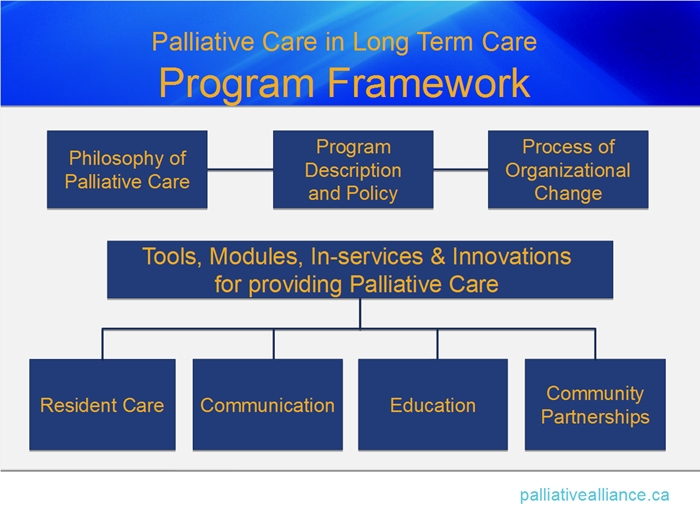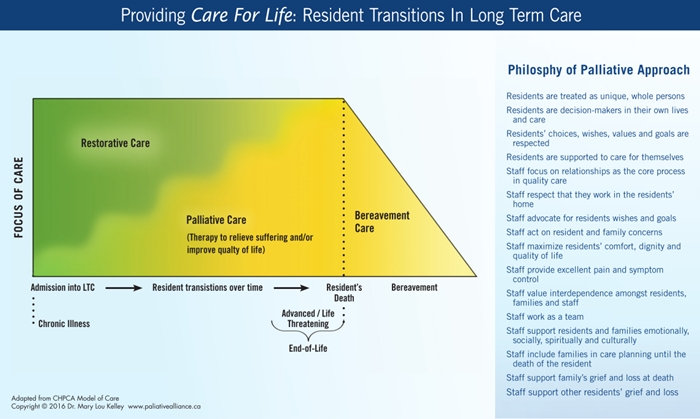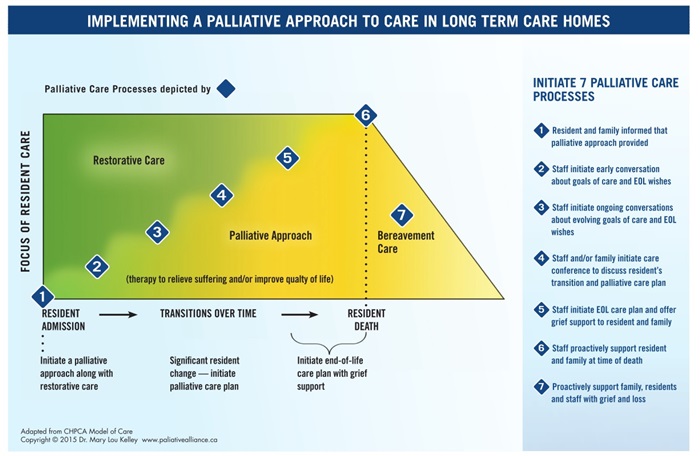Project Results
- Environmental Scan Results
- Publications
- Applying the Kelley Model for Community Capacity Development
- Videos and Interviews
- Diagrams
Environmental Scan Results
There are several structural, cultural and societal issues that challenge providing Palliative Care in Long Term Care (LTC). A four phase community capacity building model was used as a theory of change to modify the culture of LTC homes and develop Palliative Care programs. Participatory action research methodologies were used to complete a comprehensive environmental scan of the antecedent conditions in 4 LTC homes in Ontario. The results of this environmental scan highlighted existing antecedent conditions in each home. Improving the comfort and quality of care for residents at the end-of-life was a shared vision for change amongst all staff groups, however staff across all discipline did not feel empowered to influence organizational change. Teamwork and communication were great challenges due to low staffing levels, scopes of practice and the professional hierarchy of staff.
The LTC homes used the results of the environmental scan to develop educational, clinical and policy related interventions. View the Environmental Scan Results (PDF).
Diagrams
Figure 1: Framework for a Palliative Care Program
Figure 2: Philosophy of Palliative Care
Description:
Long term care homes are often the final home of a person who is admitted there for care. Most residents, on admission, are living with multiple chronic illnesses and often dementia. These are progressive conditions where cure is not possible; quality of life is the primary goal.
Upon admission to long term care, it is not uncommon that residents are in the last year of life. The implication of this is that from day to day or week to week the health of the resident often fluctuates. The overall trajectory of the resident’s health during this time is increasing frailty and decline.
Long term care home staff ability to provide a palliative approach to care to all residents from the time of their admission is essential. Supporting residents through their transitions from admission to death is what long term care homes must do if the overall goal is to provide CARE FOR LIFE. Residents have been shown to have the best quality of life when they can die at home in their long term care home where the staff know them best and the environment is familiar.
This figure depicts a residents' journey from admission to death in a long term care home. The focus of resident care is illustrated using the colours green and yellow. Green represents restorative care and yellow is the palliative approach to care. Both restorative care and the palliative approach are philosophies of care beginning on admission. The colours representing the focus of care are blended together to reflect the overall approach to care in the long term care home. These approaches are not mutually exclusive, and the blending of colours demonstrates that both approaches can be used simultaneously. The right side bar on this figure describes the components of this blended philosophy which we call CARE FOR LIFE.
Figure 3: Implementing a Palliative Approach to Care in a Long Term Care Home
Description:
This figure depicts the residents' journey from admission to death in a long term care home and illustrates seven key palliative care processes that form the palliative care program.
The focus of resident care is illustrated in the background using the colours green and yellow. Green represents restorative care and yellow is the palliative approach to care. Both restorative care and the palliative approach are philosophies of care and both should begin on admission. They are blended together in a care plan. Each resident's goals of care are individualized according to their health status and care plans are adjusted often as residents' conditions change. Overall, as the resident's health declines over time, the focus of care transitions from primarily restorative to primarily a palliative approach. Care also extends after death to include bereavement support for the family, staff and other residents.
In the foreground of the figure, are seven blue diamonds. Each of these blue diamonds represents a key palliative care process in the long term care home. They are placed in sequence from admission to death and bereavement care. Collectively these seven process compose the palliative care program. Staff can use these diamonds as general guidelines for when to implement each of the key processes and to initiate development of palliative care plans.









